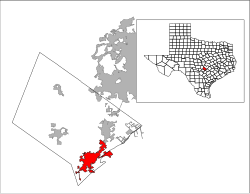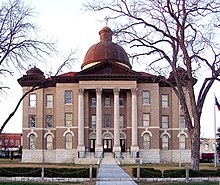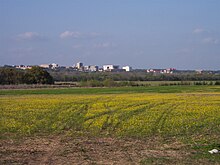San Marcos, Texas: Difference between revisions
No edit summary |
|||
| Line 149: | Line 149: | ||
* Post-rock band [[This Will Destroy You]] is based in San Marcos. |
* Post-rock band [[This Will Destroy You]] is based in San Marcos. |
||
* Noted Chicago-based improvisational comedian [[Cameron Goldapp]] was born and raised in San Marcos, TX. |
* Noted Chicago-based improvisational comedian [[Cameron Goldapp]] was born and raised in San Marcos, TX. |
||
* Noted Air Force Weather Meteorologist Joli Babbitt once lived in San Marcos. |
|||
*Juan Gotti Chicano Rap Artist was also born in San Marcos |
*Juan Gotti Chicano Rap Artist was also born in San Marcos |
||
Revision as of 08:30, 26 February 2009
City of San Marcos | |
|---|---|
 | |
 | |
| Country | United States |
| State | Texas |
| Counties | Caldwell, Guadalupe, Hays |
| Government | |
| • Mayor | Susan Narvaiz[1] |
| Area | |
| • Total | 18.2 sq mi (47.4 km2) |
| • Land | 18.2 sq mi (47.2 km2) |
| • Water | 0.1 sq mi (0.3 km2) |
| Elevation | 617 ft (188 m) |
| Population (2008) | |
| • Total | 50,371 |
| • Density | 1,907.5/sq mi (736.4/km2) |
| Time zone | UTC-6 (CST) |
| • Summer (DST) | UTC-5 (CDT) |
| ZIP codes | 78666-78667 |
| Area code | 512 |
| FIPS code | 48-65600Template:GR |
| GNIS feature ID | 1375971Template:GR |
| Website | ci.san-marcos.tx.us |

San Marcos is a city in the U.S. state of Texas, and is the county seat of Hays County. San Marcos is located on the Interstate 35 corridor, between Austin and San Antonio.[2] Founded on the banks of the San Marcos River, the area is considered to be among the oldest continuously inhabited sites in the Northern Hemisphere.[3] San Marcos is home to Texas State University-San Marcos, and the Aquarena Center .[4] The population was 50,371 in 2008.[5]
Although the majority of San Marcos lies in Hays County, small portions of the city extend into neighboring Caldwell and Guadalupe counties. While the Hays and Caldwell county portions are part of the Austin–Round Rock Metropolitan Statistical Area, the small portion in Guadalupe County is part of the San Antonio Metropolitan Statistical Area.
History
Archeologists have found evidence at the San Marcos River associated with the Clovis culture, which suggests that the river has been the site of human habitation for more than 10,000 years. The headwaters of the cool, clear river are the San Marcos Springs, fed by the Edwards Aquifer. The San Marcos Springs are the second largest collection of springs in Texas. Never in human history has the river run dry.
In 1689, Spaniard Alonso de Leon led an expedition from Mexico to explore Texas and establish missions and presidios in the region. De Leon's party helped blaze the El Camino Real (later known as the Old San Antonio Road), which followed present-day Hunter Road, Hopkins Street, and Aquarena Springs Drive (the route later shifted four miles to the south; it is now followed by County Road 266, known locally as Old Bastrop Highway). De Leon's party reached the river on April 25, the feast day of St. Mark the Evangelist; the river was thus named the San Marcos. [3][6]
In 1755, San Francisco Xavier de Gigedo presidio and the missions San Francisco Xavier de Horcasitas, Nuestra Señora de la Candelaria, and San Ildefonso were relocated from present-day Milam County to the San Marcos River. Historians still debate whether the Spanish settlements were located at the San Marcos Springs or another location. In April 1808, a small group of Mexican families settled at the Old Bastrop Highway crossing of the river, and named the settlement Villa de San Marcos de Neve. The settlers were plagued by floods and Indian raids, and the settlement was abandoned in 1812.[7]
In November 1846 the first Anglos settled in the vicinity of the San Marcos Springs. The Texas Legislature organized Hays County on March 1, 1848, and designated San Marcos as the county seat. In 1851 a town center was laid out about a mile southwest of the headwaters of the river. The town became a center for ginning and milling local agricultural products. The town's most notable founder and early settler was Gen. Edward Burleson, a hero of the Texas Revolution and former vice president of the Republic of Texas. Burleson built a dam on the upper reaches of the river in 1949. The dam powered several mills, including on within present-day Sewell Park.

In the decade following the arrival of the International-Great Northern Railroad in 1881, cattle and cotton provided the basis for the growth of San Marcos as a center for commerce and transportation.
In 1899, Southwest Texas State Normal School (now known as Texas State University-San Marcos) was established as a teacher's college to meet demand for public school teachers in Texas. In 1907 the private San Marcos Baptist Academy was established[8], furthering education as an important industry for the town. The demands of World War II forced the town's industry to diversify, and with the emergence of a manufacturing and light industrial sector the town began to experience growth.
In the 1960s, with the establishment of Aquarena Springs[9] and Wonder World[10] as attractions, the tourist industry became a growing part of the city's economy. By the 1960s what was now named Southwest Texas State University had grown into an important regional institution[11], and when coupled with the creation of Gary Job Corps Training Center in 1965[12], education became the largest industry in San Marcos[13]. The remarkable growth explosion of Austin further allowed San Marcos to prosper.
By 1973, San Marcos and Hays County had joined the Austin Standard Metropolitan Statistical Area.[14] By that year the city's population had grown to 25,000 citizens, along with an additional Southwest Texas State University student body of 20,000.
By 1990, the city's population had grown to 28,743, by 2000 it reached 34,733, and by 2008 the city's population had grown to 50,371, and the university now known as Texas State University, boasted a student body of 28,121.[15]
Geography

San Marcos is located at 29°52′46″N 97°56′20″W / 29.87944°N 97.93889°WInvalid arguments have been passed to the {{#coordinates:}} function (29.879387, -97.938829)Template:GR in an area locally referred to as Central Texas. This is 29 miles southwest of Austin and 47 miles northeast of San Antonio. Interstate 35 is the main highway through the town and the spring-fed San Marcos River is a notable water feature. The city is also situated on the Balcones Fault. The eastern part of the city is blackland prairie suitable for farming; the western part consists of rolling hills.
According to the United States Census Bureau, the city has a total area of 18.3 square miles (47.4 km²).Land constitutes 18.2 square miles (47.2 km²), and 0.1 square miles (0.3 km²) of it (0.60%) is water.
The San Marcos River area is considered by many archaeologists to be the oldest, continuously inhabited area in the Northern Hemisphere. [3]
Police Department
The Chief of Police is Howard Williams
The San Marcos Police Department was embroiled in an controversy that resulted from a August 8, 2008, traffic stop. While a local couple's dog was choking to death in the car during the August 8, traffic stop, Officer Paul Stephens can be heard saying, "It's a dog, okay? You can get another one. Relax."[16] Officer Stephens was later reprimanded and ordered to get sensitivity training.[17] The owner of the dog and Texas State University student was interviewed on Good Morning America stating "I feel that an oral [reprimand] really isn't a punishment at all. It's nothing really."[18] Police Officer Joyce Bender, who was also at the scene, handled the dog and believed it was already deceased.[19] The honesty of the police department and Officer Joyce Bender has come into question regarding the incident since the dog was still biting one the couple's finger.[20] There have since been calls for the firing of Officer Paul Stephens.
Demographics
As of the censusTemplate:GR of 2000, there were 34,733 people, 12,660 households, and 5,380 families residing in the city. The population density was 1,907.5 people per square mile (736.4/km²). There were 13,340 housing units at an average density of 732.6/sq mi (282.8/km²). The racial makeup of the city was 72.55% White, 5.53% African American, 0.65% Native American, 1.23% Asian, 0.11% Pacific Islander, 17.03% from other races, and 2.90% from two or more races. Hispanic or Latino of any race were 36.50% of the population.
There were 12,660 households out of which 19.2% had children under the age of 18 living with them, 27.9% were married couples living together, 10.1% had a female householder with no husband present, and 57.5% were non-families. 31.0% of all households were made up of individuals and 5.7% had someone living alone who was 65 years of age or older. The average household size was 2.31 and the average family size was 3.08.
In the city the population was spread out with 15.4% under the age of 18, 41.9% from 18 to 24, 24.8% from 25 to 44, 10.7% from 45 to 64, and 7.2% who were 65 years of age or older. The median age was 23 years. For every 100 females there were 96.8 males. For every 100 females age 18 and over, there were 95.4 males.
The median income for a household in the city was $25,809, and the median income for a family was $37,113. Males had a median income of $25,400 versus $22,953 for females. The per capita income for the city was $13,468. About 13.8% of families and 28.5% of the population were below the poverty line, including 22.1% of those under age 18 and 15.1% of those age 65 or over.
The San Marcos River


The San Marcos River rises from the San Marcos Springs. The springs are home to several threatened or endangered species, including the Texas Blind Salamander, Fountain Darter, and Texas Wild Rice. The river is a popular recreational area, and is frequented for tubing, canoeing, swimming, and fishing.
The river begins at San Marcos Springs, rising from the Edwards Aquifer into Spring Lake. Access to much of the headwaters is restricted due to the delicate ecosystem and numerous rare species. The upper river flows through Texas State University and San Marcos, and is a popular recreational area. It is joined by the Blanco River after four miles, passes through Luling and near Gonzales flows into the Guadalupe River after a total of 75 miles (121 km). This course is the first section of the Texas Water Safari.

Culture

The culture of San Marcos is greatly enriched by the city's diversity. Home to a growing Hispanic population, and a small but influential African-American population, the city hosts many annual events that highlight its different cultures, such as the annual VIVA! Cinco de May Celebration, the Texas Natural & Western Swing Festival, Juneteenth celebrations, and the Sights and Sounds of Christmas.

San Marcos benefits greatly by the presence of Texas State University and its large student population. The influx of youth contributes toward keeping the city vibrant, as exemplified by a thriving music scene. In addition, the university and local school district provide many opportunities for entertainment through the various student artistic productions, and athletic events.
Those in San Marcos enjoy a life centered greatly around nature. The presence of the pristine San Marcos River and an ample city park system provide plentiful outdoor opportunities. The admiration for nature lends to a city pride in its scenic natural beauty, and the unique and endangered species which also call San Marcos home.
The Square
San Marcos's town center was laid out in 1851. The square was recently the focus of a multi-million dollar restoration project. It is also one of the primary sources of entertainment for Texas State students.
Education
In additon to Texas State University and the San Marcos Baptist Academy, San Marcos is served by the San Marcos Consolidated Independent School District. Gary Job Corps Center is located a few miles east of the center of town.
Transportation
Notable Texans and San Marcos
- Lyndon Baines Johnson was educated at Texas State University, then called the Southwest Texas State Teachers College.[21][22] Many landmarks on campus and around town are named for him, including a main thoroughfare, a student center, a statue, and a museum.[23][24][22][25]
- Country music star George Strait graduated from Southwest Texas State University.[21] A club (George's) located in the basement of the LBJ Student Center, is named in his honor.[26]
- The rock band Blue October is based in San Marcos.[27]
- Folk singer-songwriter Terri Hendrix is based in San Marcos.
- Tino Villanueva, distinguished poet, editor, critic, university profesor and Chicano painter was born in San Marcos.
- Ty Detmer, a Heisman-winning quarterback from Brigham Young University was born in San Marcos.
- Horror author Scott A. Johnson received his Bachelors Degree from Texas State University, then called Southwest Texas State University, in 2002.
- San Marcos police officer and rescue-recovery diver Daniel Misiaszek founded the San Marcos Area Recovery Team (SMART) in 1988 and set a World Record for the longest scuba dive in open water of 60 hours and 24 minutes on September 3, 2001.
- San Marcos native Taryn Davis, founded "The American Widow Project", after husband CPL Michael Davis was killed in action in Iraq on 21 May 2007. The group is dedicated to preserving the memories of soldiers through military widows & widowers in sharing tears, laughter, and memories of their loved ones.
- Post-rock band This Will Destroy You is based in San Marcos.
- Noted Chicago-based improvisational comedian Cameron Goldapp was born and raised in San Marcos, TX.
- Juan Gotti Chicano Rap Artist was also born in San Marcos
Footnotes
- ^ "2007 State of the City Address" (PDF) (Press release). Mayor Susan Narvaiz. 2007-10-17. Retrieved 2008-04-08.
- ^ Preserve America Community: San Marcos, Texas
- ^ a b c San Marcos Historic Downtown National Register District, "San Marcos--A Brief History"
- ^ Aquarena Center : Texas State University
- ^ http://www.ci.san-marcos.tx.us/news/2008/Docs/2008_Annual_Report.pdf
- ^ Convention & Visitor Bureau: San Marcos, Texas Retrieved on 2008-02-23.
- ^ Spanish Colonial Missions, Villas (towns) and Presidios (forts) Along the Camino Real: starting in Mexico Retrieved on 2008-12-16.
- ^ About Us - San Marcos Baptist Academy
- ^ History : Aquarena Center : Texas State University
- ^ Wonder World Park Attractions
- ^ Handbook of Texas Online - TEXAS STATE UNIVERSITY-SAN MARCOS
- ^ Gary Job Corps Center-History
- ^ Handbook of Texas Online - SAN MARCOS, TX
- ^ Handbook of Texas Online - HAYS COUNTY
- ^ About Texas State : Texas State University
- ^ http://www.keyetv.com/mostpopular/story/San-Marcos-Couple-Blame-Traffic-Stop-for-Dog-Death/emOR-Rf2cE2U_RI99ndZeg.cspx
- ^ http://www.keyetv.com/content/news/topnews/story/San-Marcos-Officer-Gets-Death-Threats-For-Its/wtw4QdtTTE-LC8guKXhY-w.cspx
- ^ http://abcnews.go.com/GMA/story?id=5601299&page=1
- ^ http://www.sanmarcosrecord.com/breakingnews/local_story_234161016.html
- ^ http://www.sanmarcosrecord.com/breakingnews/local_story_234161016.html
- ^ a b Points of Pride : Texas State University
- ^ a b LBJ statue returns to campus : University News Service : Texas State University
- ^ San Marcos Historic Downtown National Register District
- ^ Campus : Dean of Students : Texas State University
- ^ LBJ Museum of San Marcos History
- ^ The San Marcos Daily Record, 11/18/2004, Page 8A, Alumni Events
- ^ Blue October, Voxtrot, Brandon McFall was born in San Marcos- Joe Gross, Austin American-Statesman
External links
- City of San Marcos
- Welcome to San Marcos - A Visitor's Guide
- Economic Development San Marcos
- San Marcos from the Handbook of Texas Online
- San Marcos Area Chamber of Commerce
- craigslist: san marcos
- Template:Geolinks-US-cityscale
- Texas State University - San Marcos
- San Marcos Convention and Visitor Bureau
- 78666.com - Guide to San Marcos, Texas
- Visit San Marcos - The San Marcos Hospitality Association
- San Marcos, Texas: Home of Southwest Texas State University
- Hays County... San Marcos, TEXAS
- Summer in San Marcos - About.com




